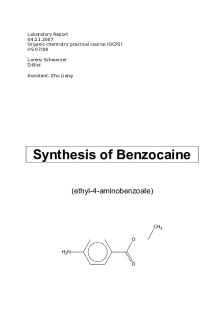Benzocaine Lab Report PDF

| Title | Benzocaine Lab Report |
|---|---|
| Author | Victoria Zona |
| Course | Organic Chemistry II Laboratory |
| Institution | Auburn University |
| Pages | 6 |
| File Size | 182.3 KB |
| File Type | |
| Total Downloads | 15 |
| Total Views | 151 |
Summary
Benzocaine Lab Report...
Description
Experiment 6: Synthesis of Benzocaine October 15, 2019 TA: Amanda Chown CHEM 2081-001
Introduction In the late 1800s, cocaine was commonly used as an anesthetic in surgery and dentistry, but the ill effects of the drug led chemists to synthesize a less toxic drug to use as an anesthetic. Studies indicated that a successful analog should be a derivative of an aromatic acid, with the carbonyl group separated from a tertiary amine by a chain two to four atoms in length. As a result, two analogs were synthesized from cocaine: Benzocaine and Novocaine.4 Benzocaine and Novocaine are drugs that are just as effective of an anesthetic as cocaine but are significantly lower in toxicity. Benzocaine lacks the tertiary amine component; therefore, it is less active as an injectable drug. Today, benzocaine is extensively used as a topical pain reliever, such as Orajel, which is used to reduce pain caused by teething, cold sores, canker sores, and toothaches.4
Conclusion In this experiment, benzocaine was synthesized by reacting 4-Aminobenzoic acid with ethanol (CH3CH2OH) and sulfuric acid (H2SO4).1 The reaction proceeded as expected with little to no error. The experiment was expected to yield 0.149 g of benzocaine. The actual yield was 0.129 g leading to a percent yield of 87%. While transferring the product from the long-neck round-bottom flask to the watch glass, a small amount of the solid product remained in the flask because it was not easily transferrable out of the flask to the watch glass. This is a possible contributing factor leading to a less than perfect percent yield. A way to improve this experiment would to ensure that all of the product is transferred to the watch glass. If this would have happened, then the percent yield would have likely been closer to 100%. A future research experiment based on this data and conclusion would be instead of using ethanol as a means of synthesizing benzocaine, methanol could be used instead. Considering that methanol has one less
carbon atom and less hydrogen atoms, this could allow the reaction to take place in half the amount of time than when ethanol was used. Instead of waiting an hour for the reaction to take place, just wait 30 minutes. Even though the ethanol in this experiment was successful and produced a high percent yield, it would be interesting to see if methanol produced the same results with it having less carbon and hydrogen atoms present in the molecule. Based on the structures of cocaine, novocaine, and benzocaine, it is expected that there would be a difference in melting points between the three. Cocaine is the largest molecule and therefore has the higher melting point of 98°C due to the larger surface area.3 Benzocaine has the second highest melting point at 92°C because it is a tightly packed molecule. Novocaine has the smallest melting point at 61°C because it is a longer molecule that is not as compressed as the other two molecules.2
Calculations 0.12𝑔&𝐶( 𝐻( 𝑁𝑂, ×
1&𝑚𝑜𝑙&𝐶( 𝐻( 𝑁𝑂, 1&𝑚𝑜𝑙 &𝐶4 𝐻55 𝑁𝑂, & = 0.0009&𝑚𝑜𝑙&𝐶4 𝐻55 𝑁𝑂, & × 1&𝑚𝑜𝑙 &𝐶( 𝐻( 𝑁𝑂, 137.14𝑔&
0.0009&𝑚𝑜𝑙 &𝐶4 𝐻55 𝑁𝑂, ×
165.19𝑔&𝐶4 𝐻55 𝑁𝑂, = 0.149𝑔&𝐶4 𝐻55 𝑁𝑂, & 1&𝑚𝑜𝑙
Theoretical Yield: 0.149 g 𝐶4 𝐻55 𝑁𝑂, (benzocaine) Actual Yield: 0.129 g 𝐶4 𝐻55 𝑁𝑂,
𝑃𝑒𝑟𝑐𝑒𝑛𝑡&𝑌𝑖𝑒𝑙𝑑 =
=
𝐴𝑐𝑡𝑢𝑎𝑙&𝑌𝑖𝑒𝑙𝑑& × &100% 𝑇ℎ𝑒𝑜𝑟𝑒𝑡𝑖𝑐𝑎𝑙&𝑌𝑖𝑒𝑙𝑑&
0.129&g&𝐶4 𝐻55 𝑁𝑂, && × &100% &0.149&g&𝐶4 𝐻55 𝑁𝑂, 𝑃𝑒𝑟𝑐𝑒𝑛𝑡&𝑌𝑖𝑒𝑙𝑑 = 87%
Mechanism
Figure 1: Reaction mechanism for the synthesis of benzocaine from 4-Aminobenzoic acid with ethanol (CH3CH2OH) and sulfuric acid (H2SO4).
Figure 2 (above): The structures of the analogs derived from cocaine.
Table 1 (below): The IUPAC name and chemical formulas of the analogs derived from cocaine. Cocaine
Novocaine
Benzocaine
IUPAC Name:
IUPAC Name:
IUPAC Name:
methyl (1R,2R,3S,5S)-3benzoyloxy-8-methyl-8azabicyclo[3.2.1]octane-2carboxylate
2-(diethylamino)ethyl 4aminobenzoate
ethyl 4-aminobenzoate
Chemical Formula: C7H21NO4
Chemical Formula: C9H11NO2 Chemical Formula: C13H20N2O2
References
1. Morvant, Mark C, et al. CHEM 2081 Organic Chemistry II Laboratory Manual. HaydenMcNeil, LLC, 2019. 2. Gillespie, Claire. “What Factors Affect Melting Point?” Sciencing, 2 Mar. 2019, sciencing.com/factors-affect-melting-point-8690403.html. 3. “PubChem.” National Center for Biotechnology Information. PubChem Compound Database, U.S. National Library of Medicine, pubchem.ncbi.nlm.nih.gov/. 4. “Orajel (Benzocaine Topical) - Side Effects, Dosage, Interactions - Drugs.” EverydayHealth.com, 18 Jan. 2016, www.everydayhealth.com/drugs/orajel....
Similar Free PDFs

Benzocaine Lab Report
- 6 Pages

LAB 5 - Lab report
- 4 Pages

Lab 8 - lab report
- 6 Pages

TLC Lab Lab Report
- 4 Pages

Lemonade Lab - Lab report
- 4 Pages

Post Lab - lab report
- 2 Pages

TLC lab - Lab report
- 3 Pages

Lab 8 - lab report
- 3 Pages

Lab 6 - Lab Report
- 6 Pages

Lab Report 5 - lab
- 5 Pages

Planaria lab - lab report
- 6 Pages

Acceleration lab - lab report
- 3 Pages
Popular Institutions
- Tinajero National High School - Annex
- Politeknik Caltex Riau
- Yokohama City University
- SGT University
- University of Al-Qadisiyah
- Divine Word College of Vigan
- Techniek College Rotterdam
- Universidade de Santiago
- Universiti Teknologi MARA Cawangan Johor Kampus Pasir Gudang
- Poltekkes Kemenkes Yogyakarta
- Baguio City National High School
- Colegio san marcos
- preparatoria uno
- Centro de Bachillerato Tecnológico Industrial y de Servicios No. 107
- Dalian Maritime University
- Quang Trung Secondary School
- Colegio Tecnológico en Informática
- Corporación Regional de Educación Superior
- Grupo CEDVA
- Dar Al Uloom University
- Centro de Estudios Preuniversitarios de la Universidad Nacional de Ingeniería
- 上智大学
- Aakash International School, Nuna Majara
- San Felipe Neri Catholic School
- Kang Chiao International School - New Taipei City
- Misamis Occidental National High School
- Institución Educativa Escuela Normal Juan Ladrilleros
- Kolehiyo ng Pantukan
- Batanes State College
- Instituto Continental
- Sekolah Menengah Kejuruan Kesehatan Kaltara (Tarakan)
- Colegio de La Inmaculada Concepcion - Cebu



